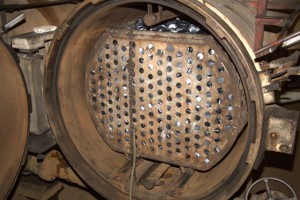FACE Investigation Documents Factors Contributing to a Worker’s Death Inside Pressure Cooker
Posted on by

The headlines a few weeks ago were alarming. The tragic death of a worker in a 270-degree oven three years ago led to a $6 million agreement to settle criminal charges in what Los Angeles District Attorney Jackie Lacey said was the largest payout in a California workplace death (see news report). The California Fatality Assessment and Control Evaluation (FACE) program investigated this case, and the investigation report provides additional details: On Thursday, October 11, 2012, at approximately 5:30 a.m., a 62-year-old Hispanic male machine operator working in a food processing plant died when he was sealed inside a pressure cooker. The victim was assigned the task of loading the steam pressure cooker called a “retort” with carts of canned tuna using a pallet jack. When the victim’s supervisor went to check on the work progress, he noticed the pallet jack and carts loaded with canned tuna in front of the retort. The inlet door was open and the outlet door was closed. The victim was not visible. The supervisor instructed a co-worker to load the retort while he went to look for the victim. The co-worker loaded the retort with the carts containing 12,000 pounds of canned tuna but did not look inside prior to loading. The inlet door to the retort was then closed and sealed by another employee and the steam pressure turned on. After an extensive search for the victim, the supervisor had the retort turned off and the outlet door was unsealed and opened. The victim was found unresponsive inside the retort by the outlet door and pronounced dead at the scene by responding police and fire personnel.
How Could This Happen?
The employer had written procedures for both confined spaces and permit-required confined spaces for other vessels in the plant. However, the company supervisor never identified the retorts as confined spaces and there were no written policies or procedures for loading them. As a consequence, the employees working with the retorts never received confined space or permit-required confined space training. Had the employer conducted and documented periodic safety audits and inspections that identified all hazardous work areas for employees, the retorts would have been classified as a permit-required confined space. If the retorts had been identified as a permit-required confined space, there would have likely been the proper procedures, controls and training to safely load the pallets. The tragedy points to the need for comprehensive safety programs in workplaces where the work process may pose inherent risks of serious job-related injury or death.
How Do We Prevent this from Happening Again?
Confined space deaths continue despite a wealth of information on how to prevent them. The following are guidelines for working in confined spaces.
- Companies should identify all confined spaces in their facility and develop and implement written confined space entry procedures for each confined space.
- Companies should post warning signs at all confined space entry points. The signs should be understandable to workers who cannot speak or read English.
- Companies should identify all workers who are potentially exposed to confined space hazards and provide training to those employees, including engulfment, oxygen deprivation, presence of toxic gases and mechanical and electrical hazards.
- Companies should ensure that the workers understand the nature of confined space hazards and are familiar with standard confined space entry procedures.
- Training should be provided before an employee is assigned the specific tasks and a refresher training should be provided at least annually or whenever there is a change in assigned duties, in confined space operations or an update in the confined space entry procedures.
- Confined space training, as well as all other safety training should be documented and kept on file with the employer.
- All written and oral training should be offered in the appropriate language and literacy level of the employees who are being trained.
- Supervision through random observation should be conducted to prevent unauthorized entry and ensure that employees follow all written safety procedures and training.
- Corrective action should be taken whenever an employee is observed performing tasks outside of the company’s safety procedures.
For more information see the NIOSH Confined Space Topic Page and the blog A Wrench in the Gear: Lockout/tagout in the food industry.
This case, report #12CA012, was investigated by the California FACE program. California FACE is one of seven FACE programs funded by the National Institute for Occupational Safety and Health. Investigations conducted through the FACE program allow the identification of factors that contribute to fatal work-related injuries. This information is used to develop comprehensive recommendations for preventing similar deaths, and as in this case, may provide the scientific evidence that may be used by policymakers in the public or private sectors to make regulatory, legal, or legislative decisions.
Robert Harrison, MD, is a Professor of Medicine at UC San Francisco and Chief of the Occupational Health Surveillance and Evaluation Program at the California Department of Public Health.
Laura Styles, MPH, is a Research Scientist in the Occupational Health Branch of the California Department of Public Health.
Posted on by

